1001 Circles: Train your robot with DrTechniko
1001 Circles is a series of stories that show what a math circle might be like, from the point of view of circle leaders. We hope these stories will inform and inspire you to lead a circle of your own. And if you lead a math circle, an engineering club, or an informal playgroup, we would like to hear your story or interview you. Write moby@moebiusnoodles.com to talk about your adventures.

Today we meet DrTechniko, who wants to educate young minds about the scientific thought process, computer science and technology – and one day fill the world with young geniuses. DrTechniko’s stories and games teach kids concepts about programming, artificial intelligence, nanotechnology, computer design in the same fun and engaging way as “grandma’s storytelling time” when we were kids.
DrTechniko in real life is Nikos Michalakis. Nikos graduated from MIT with honors (TBP, HKN) with an undergrad and Masters degree in Electrical Engineering and Computer Science and a minor in Mathematics. He then did post-graduate studies at NYU’s Courant Institute. He has done research at MIT’s Media Lab and Computer Science and Artificial Intelligence laboratories and companies like Nokia and Sun Microsystems. He has published his research in prestigious conferences. He also gained practical experience on the applications of science and technology by being involved with multiple high-tech start-up companies over the years. He currently works at Knewton, an adaptive learning education technology company. He lives in Williamsburg, Brooklyn with his wife and their two sons.
Here is DrTechniko’s story, which originally appeared on his site. Adaptations for older and younger kids are added at the end.
Last Sunday, I taught six kids of ages 5 to 7 how to program. “In what programming language?” you may ask. Well…I didn’t use a programming language, at least none that you know of. In fact, I didn’t even use a computer. Instead, I devised a game called “How To Train Your Robot”. Before I explain how the game works, let me tell my motivation.
I learned how to program during my freshman year at MIT when I was 19. It’s not because I didn’t have a computer at home or I hadn’t heard about programming languages. It was because (a) I thought programming was boring and (b) no one had told me why I should bother. In fact, my computer teacher in high school had told me “you don’t need to waste your time learning how to program. Now we have visual tools to build programs. Programming languages are already obsolete.” That was in 1994 and he was referring to Visual Basic. Luckily for me MIT wiped all that nonsense away in a matter of weeks. But does one need to wait to go to college to get the proper education?
Learning how to program is going to be the most useful new skill we can teach our kids today. More than ever our lives depend on how smart we are when we instruct computers. They hold our personal data and they make decisions for us. They communicate for us and they are gradually becoming an extension of our brains. If we don’t learn programming as part of our childhood, we will never evolve. As the famous futurist, Ray Kurzweil, put it “The only second language you should worry about your kids learning is programming.”
How To Train Your Robot
The game works as follows: every kid is turned into a “robot master” and their mom or dad becomes their “robot”. I give each kid a “Robot Language Dictionary” and explain to them that this is the language their robot understands. The dictionary has symbols for “move left leg forward”, “turn left”, “grab”, “drop” etc.
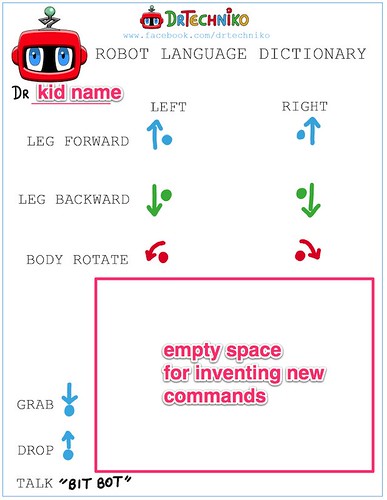
The goal is for the robots to go through an obstacle course, pick up a ball and bring it back. The kids have to write a program that will tell the robot how to do all that. Every time they write a program, they hand it to their robot and the robot executes it. To do that, I give each kid a pen and paper where they copy symbols from the dictionary to write their programs and off their robots go!
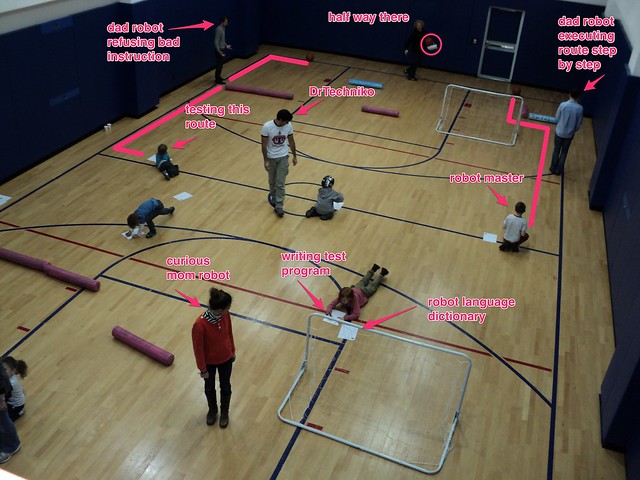
The fun part begins when each robot retrieves the ball. Now I let kids invent their own moves and symbols that they add to their dictionary and then teach their robots. There is no limit to what the kids come up with.
This is my favorite program (written by a five year old girl):

I designed the class to teach some very basic principles of computer science and programming:
Programming languages are just another way to communicate to an entity (via programs).
Programs are recipes for automating stuff.
However, I was pleasantly surprised on how much more the kids learned. On their own they figured out the following things (in a 30-min session):
- Program Parametrization: Instead of putting a forward step ten times, they put a 10 in front of the “step” symbol (A five-year-old figure it out and asked me if she could do it).
- Composition: Grouping of a set of moves (“move left leg forward, then move right leg forward and do this combo 10 times”)
- Abstraction: “Run in a circle, then say “I’m dizzy!” , then call this the “Run Dizzy” program and do it 100 times. (For some reason, kids loved making their parents repeat stuff 100 times over.)
- Unit testing: They’d write a test program to get the parents moving a few steps, have their parents run it, then fix it and run it again, and then add a few more steps until they reach the goal.
I’ve ran the class twice now and I’ve seen the same patterns, which support my belief that when kids have fun, they get very smart and creative about programming. Many of the parents plan to play the game at birthday parties. If you have questions about how to set up the game, don’t hesitate to write. You can find my contact info at www.facebook.com/drtechniko.
I was interested for a while after I designed “How To Train Your Robot” whether we can push the age limit down, so I designed a simpler game called “How To Train Your Robot To Jump.” I tried it on my son when he was 2.5, and summarized my thoughts on how we can introduce toddlers to some basic concepts.

For older kids, someone (I believe in Brazil and the US) used the game as is, with more complex robot paths. The really fun part I think is after achieving the original goal of the game, the child can create their own new “moves” (essentially language constructs). Even a 7-year-old was able to come up with iterations for loops, or mix new actions.
Another way I’ve used a modified version of the game is to introduce the older kids to conditionals, such as if_else_ and while(some Boolean expression). First, invite children to write a program with fixed moves, and then vary the layout by moving obstacles. This way, the kids have to think along the lines of if(there is an obstacle)_then(turn) and then wrap those decision-making conditionals in a while(goal not reached) loop.
Essentially the program would look like this:
while (I haven’t picked the ball) {
while (I don’t see the ball) rotate slightly left
// now we see the ball in front of us
// but there may be an obstacle
move forward
if(hit an obstacle) turn left then move forward
// now we have cleared an obstacle so let’s try again
}
I tried it on a 6-year-old and they had difficulty understanding while loops, but they got the conditionals. I think a 9-10 year old should have no problem trying that version of the game. I ended up teaching the while(condition) concept a different way to 6-year-olds using smaller tasks. I had them read things like this:
while(nikos is wearing a hat) {
clap your hands
}
It was fun and direct and they got it.
You can’t do CS without math, and math becomes more tangible when taught through CS. In fact, at MIT we all had to take a class in discrete math (combinatorics, induction, Boolean algebra, polynomials, probability, etc. etc.) since this is the foundation for algorithmic thinking and analysis, among other things.
Some of the things I think kids playing DrTechniko games learn that will help them understand math are:
- Understanding abstractions and symbols and how by applying rules to them you can build a whole axiomatic system.
This is simply done by having the kids build their own programming language and constructs on how to put things together. When a kid draws an arrow and places the number 5 in front of an arrow and assigns a meaning “jump 5 times” they are learning to build an interpret their own “algebra” or how to solve an equation using a structured mental process. - Counting.
It’s ubiquitous in computing. - Creative Problem solving.
It’s a big part of math that unfortunately is often put aside in favor of memorizing… All these games teach kids how to solve problems. - Boolean logic.
I mentioned several examples above. - Min, Max, Comparisons.
I had a class of 2nd graders figure out what is the favorite/least-favorite color of the class and they had to place their votes, then collect and partition them by color, then find the max/min. I also had them figure out how to sort themselves from tallest to shortest, by comparing their height with their neighbors. - Sets.
Another game we played was to group books by color or the first letter of the title as part of a searching algorithm exercise. They learned what a set is without even realizing. - Probability.
This is my favorite. We don’t teach that early enough and it’s such a big part of understanding our world and so important in modern mathematics/computer science and the “big data era”. Today’s science relies more and more on statistical models. As an exercise I had the class of 2nd graders build a computer that generates random-numbers using various designs from stuff they have at home. My favorite was a girl that put a bunch of numbers on a piece of paper and used her pen as a dart. She ‘d throw the dart and write down the closest number it hit! We also experimented with a random() function in real programs. I had them play with a program that would generate “fortune telling predictions” by randomly choosing words from a list.
Games like that are much more intuitive than giving a child a formula and asking them to reproduce.
Posted in A Math Circle Journey, Make
Math mind hacks: start with answers, ask for problems

Math Mind Hacks is a series of mini-posters about quick, smart activities that grow mathematical minds. Today’s hack is inspired by a story Gregorio Morales told in response to my interview 5-Year-Olds Can Learn Calculus:
I work with children 12-16 years old. My idea is to incorporate creativity in their mathematical works. For example, one of the activities I use is to show a number (for example, 9) as the answer of a problem, and then I ask them for the problem. At first the problems are rather weak: “I have 4 apples and Peter gives me 5 more, how many apples do I have now?” But as the class goes on, some very beautiful problems arise. Maybe another day the number is 259 and they find it harder to come with a nice problem. And another day I go to class with the number 1278513. It’s incredible how many mathematical concepts they are able to invent in order to find a beautiful problem whose answer is my given number.
Posted in Grow
Math Storytelling Day, and math like music and dance: Newsletter August 4
Subscribe and read archives
Pinterest | Twitter | Facebook | Google+
Hi, I am Moby Snoodles, and this is news about Natural Math.
Send me your questions, comments, and stories of math adventures at moby@moebiusnoodles.com

In this newsletter:
- Math Storytelling Day
- Quick bits from our blog
- 1001 Circles: planning the incubator for math circle leaders
Math Storytelling Day September 25
Back in early June, the Moebius Noodles crew participated in the Maker Faire in Raleigh, NC. We enjoyed coming up with maker-style math adventures. And we’ve seen so much joy from children and adults who made their own mathematics at our booth! That’s why we want to continue that theme: MATH IS WHAT YOU MAKE OF IT.
So we decided to make MAKING our theme for this year’s celebration of Mathematics Storytelling Day, September 25. We are inviting you to join our community of kids and adults from around the world in storytelling, with your story of what you make of mathematics – in pictures or words.

In the spirit of making, with this awesome design by our illustrator Mark Gonyea, we’ll produce a small quantity of Math Maker t-shirts. See the Math Storytelling Day page for details.
Blogs and networks
What if we could learn math like children learn music within a cultural tradition? What if we could learn math by being immersed in meaning and expression from the moment we’re born? These questions come up as Malke Rosenfeld and I watch kids and adults dancing and making music. What do you think?

“Mom, it’s a fractal of square numbers!” – Yelena McManaman and her son invite you to explore multiplication patterns with Perler beads.
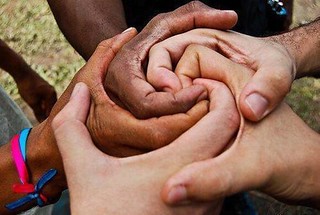
Check out this review of traditional, or new and surprising finger tricks for math from Marina Mersenne, including a way to make Fibonacci spirals with hands, and the Official Math Salute. If your kids can’t get enough of these tricks, here is how to count to 99 on your fingers that goes back to the Soroban abacus – with big thanks to Alexander Bogomolny for his photos!
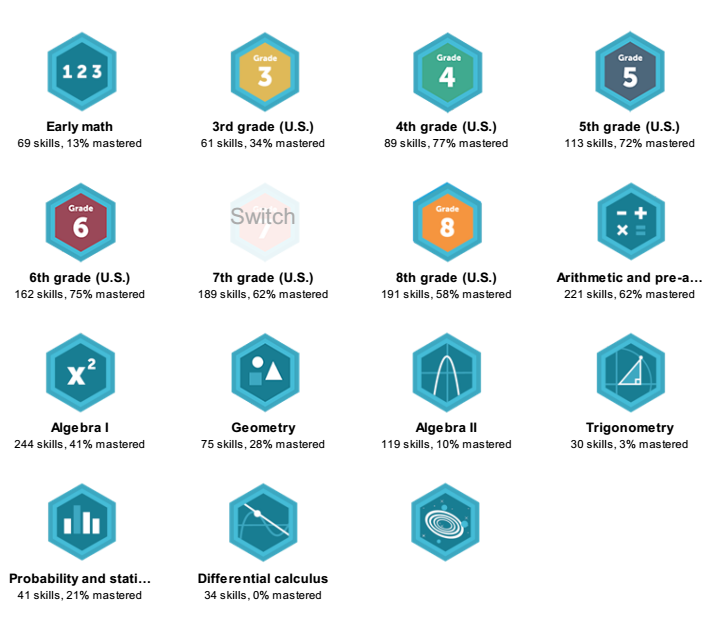
Who is this mystery person? A teacher, a US president, a young kid, or maybe a whole family sharing an account? What is that person’s real grade level in mathematics? Look at the screen capture from a Khan Academy profile, and try to guess by August 10, when we will reveal the answer.
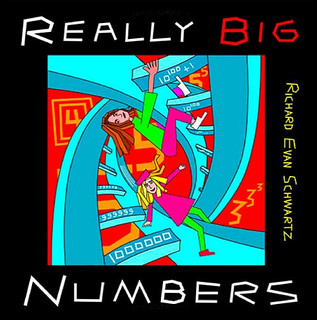
“Really Big Numbers is a small book that can take a long time to read or even look through. It is a chance to learn something new about the really big numbers. But it is also a chance to experience the awe, the mystery and the playfulness of math with your child and as a child.” Read the full review of the new book from the author of “You can count on monsters” posters.
1001 circles incubator
In the last newsletter, we announced plans for a training program for new math circle leaders. The goal for the program members will be to prepare, plan, and run their first circles this fall. The response has been very enthusiastic. We are exchanging letters with prospective members of the math circle incubator. Together, we can create a program that addresses the worries, turns dreams into plans, and makes a difference for the children.
- How can I make it relevant and age-appropriate? What are the kinds of fundamental math concepts kids can pick up from play in math circles? For example, when/how to introduce concepts like operands, calculation, logic, sets, number systems, geometry, logarithms, just to name a few… How to set the stage for kids to make connections? – Rachel R.
- My biggest hope and worry as a math circle leader is to help my kids avoid the trap I fell into. I went to 3rd semester calculus, static/dynamics, and calculus-based physics, before I imploded. I had breezed through high school and the first year of college with little effort for math. I was good at memorization and identifying patterns. I didn’t get the “why” behind any of it and no one seemed to care, as long as the grades were good. Then I hit a wall and didn’t understand why until years later. My fear is that my whole background is in the traditional way of learning math and this path is this muddle in my brain. – Brad S.
- I dream of being an effective guide for the children. I want to spark their curiosity by letting them led their own learning. I want to create an amazing place for children to work and learn and play together. – Darlene L.
- I love the Montessori math materials but would like to add addition opportunities to “play with” and discover the beauty of mathematics. – Janie J.
- My biggest worry is not being able to respond to the groups’ interests in presenting information or provide enough various opportunities of exploring math. My dream is to build up my knowledge and to share that learning adventure with my children and my community. I hope to promote curiosity and joys of learning. – Linley M.
- My greatest hope for being a math circle leader is to learn myself how to think outside of the worksheets, textbooks, and sit at a desk doing math problems mindset! – Rabia H.
Write moby@moebiusnoodles.com if you are interested in participating!
Sharing
You are welcome to share this newsletter online or in print.
Talk to you soon! Moby Snoodles, aka Dr. Maria Droujkova
Posted in Newsletter
Math Storytelling Day resources
September 25 is Math Storytelling Day! To celebrate that holiday, people tell mathematical stories to friends, family, and the whole internet. September 25 we celebrate pretend-play and traditional wisdom in mathematical stories from all over the world.
Tell the classic, traditional Hotel Infinity story.

Do an ethnomathematics craft, such as traditional sand drawing stories from the Sona tribe.
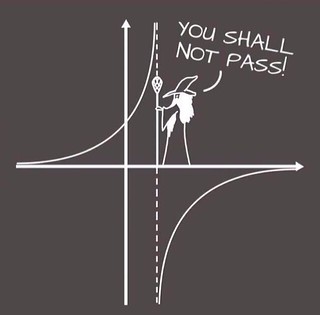
Tell math anecdotes and jokes, do skits, or post humorous pictures.
Go on scavenger hunts to find math everywhere.
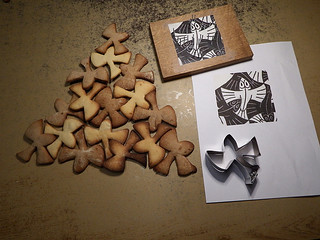
Celebrate with math food.
Read mathematical literature.
Check out past stories bloggers shared about their Math Storytelling Day celebrations!
- All the storytelling posts on Moebius Noodles
- Let’s Play Math 2013
- It’s just math 2013
- ScienceLens 2012
- Minitab 2011
- Math Mama Writes 2010
Found a good math storytelling resource? Drop us a line!
Posted in Make



